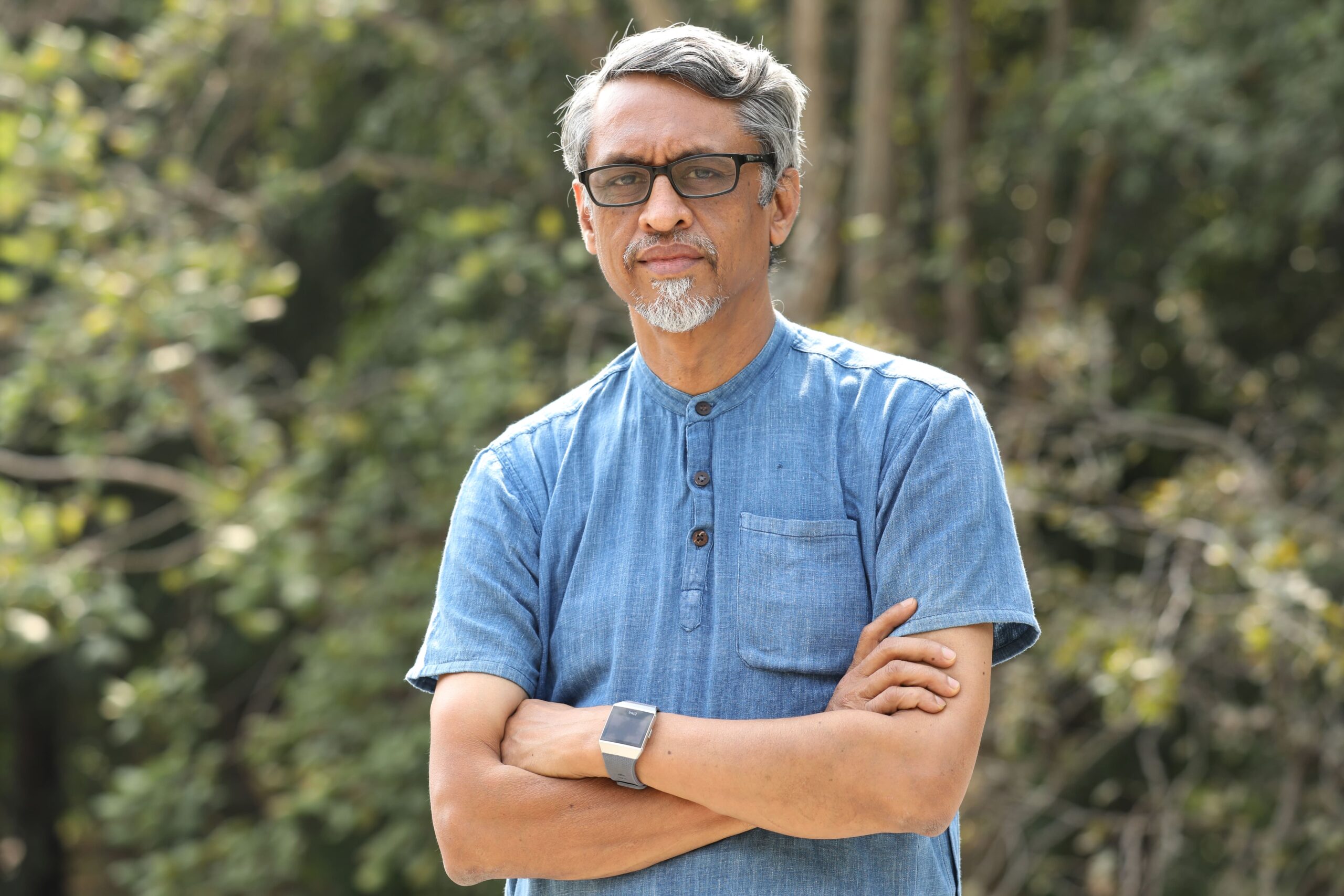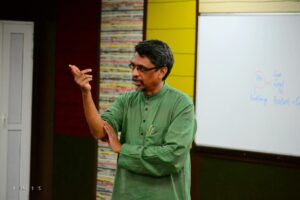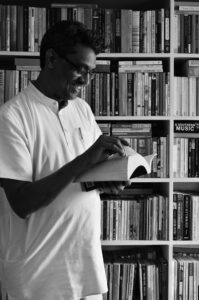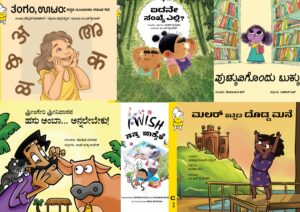While translating we are extra careful to be pure! | Interview with MS Sriram

Prof. Sriram is a faculty member at the Centre for Public Policy, IIM Bengaluru. He is also a Distinguished Fellow at the Institute for Development of Research in Banking Technology set up by the RBI. A co-author of ‘Beyond Micro-credit’ and two other books on Flow of Credit to Small and Marginal Farmers, he has also published several works of fiction in Kannada. He is now on the board of NDDB Dairy Services, Institute of Rural Management, Anand and Centre for Budget and Policy Studies. He is a Trustee of Dastkar Andhra and Sanket Trust that runs Rangashankara in Bengaluru, as well as Pratham Books.
We at Pratham Books keep delving into the magic of translations and celebrate translations. When I was chatting with MS Sriram, writer and translator, I thought we should do a series of conversations with him on translation and literature. He readily agreed to share his knowledge of languages, the process of translation, and more.
Pratham Books and StoryWeaver work to make sure children get to read wonderful books in their mother tongue. Translations are our lifeline toward achieving this goal. This interview by Hema Khurshapur, Kannada Editor at Pratham Books explores the possibilities, scope, and barriers to creating engaging picture books in mother tongue languages for children.
On Translation
You translate from Telugu and English to Kannada and have done literary experiments in your Kannada writings. How did you manage to navigate all these languages?
I am not trained in any of these languages. I translate from Telugu and English to Kannada, but I am not comfortable doing the obverse. My facility in rendering anything in Kannada is superior to rendering in other languages. English was the medium of instruction for my studies and therefore I have a fair level of comfort in that language. I was interested in Kannada literature, which led me to interact with Kannada teachers, and read quite a bit and over a period my interest turned into a passion. I have been writing in both languages since my college days. I write op-eds in newspapers and research papers in English. These are about aspects where I have been trained and I have a relative degree of comfort due to my specialisation. For me, Kannada was largely a language of literature. I have written essays, stories, and recently a novel in Kannada. I have tried humour and even poetry! But I have now settled down to writing fiction and essays.
Then there is a question of what prompts me to write. For me, usually, there are a couple of triggers. One – how am I perceived amongst the plethora of contemporary writers? In this quest to understand and learn, I read a lot of what is written by contemporary writers. Two – I am also interested in how established writers deal with a plot or a concept and how they handle some challenges. The process of writing also helps me upgrade my reading. This is a process of training oneself.
My connection with Telugu is a different story. I spent all my childhood in Karnataka. My family has been living in Bengaluru for five generations. Even as we claim to speak Telugu at home, I am conscious that the Telugu we speak has more than an acceptable sprinkling of Kannada. That does not stop me from claiming I know the language. My mother hailed from Nellore in Andhra Pradesh and her Telugu was very good. She used to speak a purer form of Telugu compared to my relatives in Bengaluru. But my Telugu significantly improved when I took up my first job in Hyderabad. I had colleagues who were largely from East and West Godavari Districts, traditionally known to speak one of the purest forms of Telugu. They were proud of their accent and command over the language. Since I was working with village-level co-operatives and had to deliver training modules in Telugu, I needed to get a better command of the language. So I started reading, listening, and writing. I also watched lots of movies. These helped to improve my Telugu. Telugu and Kannada have similar scripts and therefore reading was not a challenge. I started enjoying reading in Telugu as well.
You argue that a translation has to be faithful to the text rather than being a creative re-rendering. Why?
Even though it is quite difficult to follow this, as a rule, I believe we must be loyal. As translators, we are presenting someone else’s thoughts in our language, and taking liberties is tantamount to presenting an interpretation rather than the text. Even a loyal translation is in essence an interpretation. But a translator mustn’t feel that she owns the text. We should make efforts to understand where the original text comes from and what it stands for. Let me give you an example: Gabriel Garcia Marquez’s, ‘One Hundred Years of Solitude’ has been translated into Kannada as ‘Nooru Varshagala Ekaantha’, but it should have been translated as ‘Ondu Nooru Varshagala Ekaantha Vaasa’. Because Marquez’s text has specificity. He uses precision in his writing. His style follows the genre of Magic Realism, where there are a lot of unbelievable illusions. But he makes them believable through his precision and specificity. Illusion is Magic. Realism is in the specificity of a number. When he wrote that people were flying, he would have a specific number of people in the air, a specific colour for their wings, and the formation of feathers. The translations should be loyal not only to the text but also to the tone and style of the original. It should represent the text as well as the author. Loyalty to the spirit of the original is very important.
 You are an experienced translator. Has there been an instance where you felt challenged as a translator?
You are an experienced translator. Has there been an instance where you felt challenged as a translator?
I can think of several! Sometimes, I have even decided to drop the idea of translating. Two reasons compel me to translate. How strongly does the work pull me towards it? And how relevant is the work? I love the short stories of Telugu writer Satyam Shankara Manchi. His style resembles Kannada’s eminent writer Maasti Venkatesha Iyengar. When I read Manchi’s works, I feel the urge to bring them into Kannada. Although a few nuances in the stories are specific to Telugu, it is not hard to retain the original flavour and translate them to Kannada. The context is not alien to a Kannada reader. Translating works from an alien culture is more challenging. Take Marquez or Milan Kundera, for instance. What compels me to translate their stories is my interest to learn and practise the way they manage the narrative, their technique, their presentation, and their craftsmanship. I view translation as training in writing. When we translate, we are compelled to read the text repeatedly. In a casual reading, when the meaning of a word or a phrase is unclear, we make assumptions and proceed without interrupting the flow. So, the contextual meaning may be lost to the reader. While translating, we pay great attention to syntax, structure, flow, and timeline. So, there are two reasons for me to translate – to spread happiness and to subject myself to pain (laughs).
Are there topics that draw you and fill you with the urge to translate?
Perhaps it is easier if I say what I would not or cannot translate. I cannot, for instance, translate Umberto Eco’s books. Eco’s novels have the church as a background. They deal with Christianity, Christian traditions, conflicts between Christians and Jews, and Judaism. They are, of course, very interesting. I enjoy reading them. But I can never even think of translating them. Without a clear understanding of the context and the backdrop, the translation will be lifeless. So I’d rather stay away. I translate only when I can understand the content with its cultural background. If a foreigner translates Ananthamurthy’s ‘Samskara’, the translator may not be able to grasp its sensibilities. Only someone like A K Ramanujan can carry off the translation since he was well aware of the context and the nuances of the language. When I read Marquez or Milan Kundera, I am drawn by the way they look into human relations layer by layer, and I so admire the politics and the contemporariness their exploration creates. This encourages me to translate. Of course, a few sensibilities may remain under-perceived. This is unavoidable, is it not? I cannot possibly become Marquez or Kundera for translation! However, I would say that it is better to read multiple works of an author before attempting a translation. Then the translator gets used to the style of the writer.
As a writer of fiction, you have in the past said that the opening sentence of the story is the most challenging one to write. Is it the same while translating?
No. The real challenge is whether I should translate the story or not. The process of writing a story needs a motivational trigger from within. This usually happens naturally or at other times, I create a trigger. The writer of the original has immense choices. A translator has the text as an anchor. This makes things a bit easier. But translation is a very labour-intensive and monotonous task that needs rebuilding and recreating. It demands discipline and many tools. Sometimes a set of words in a thesaurus or dictionary just does not fit in. Often, I have called on my friends for help. When the language is too complicated and I cannot crack it, I take a break and pick up something else to read. On the other hand, writing a story is done in solitude. An act of immense reflection and privacy.
Isaac Bashevis Singer describes how he struggled to write when he migrated to America. There are no words to describe a subway in Yiddish because Poland does not have any subways, he says. Be it original writing or translation, what are the difficulties with the language?
Although I have written in Kannada on the topic of finance, I found translating ‘Bhinna Abhipraaya’ by Y V Reddy very challenging. Every language has a character – an integrated identity. Singer may have thought of ‘subway’ as an alien word. We hadn’t heard of ‘metro’ two decades ago. When Jayanth Kaikini refers to ‘Mumbai 7:55 local’ in his story, how will a reader who has never stepped outside Mandya and Maddur relate to it? So, we simply borrow words rather than trying to translate them.

Every language has limitations. Overcoming these limitations and managing to stay within the limits are both challenging. How do you translate ‘fiscal deficit’ in Kannada? When did the Kannada language acquire words that deal with democracy, government, and State finances? The concept of fiscal deficit, therefore, needs an explanation. Another example is the Finance Commission. It is an arrangement for financial transactions between the Union and the State governments. What name do you give to the Finance Commission when Kannada-speaking people have never been exposed to such arrangements in the past? Another example is the Kannada word for a swimming pool. It literally means a ‘pond for swimming.’ We have always had a word for ponds. But we have never had a word for a pond intended exclusively for swimming! A pond that cannot be deeper than some ‘x’ feet, has to be filled and drained periodically cleaned! We used to swim in a well or a pond or a lake. It wasn’t a well or a pond just because we swam in it!
‘The English language borrows words from other cultures more easily. The Oxford dictionary has a place for words like Chutney. Getting new words into Kannada does not happen so naturally as it happens with English.’
Why should we have to invent a new word for floppy disk? If ‘pen drive’ is universally accepted to describe a storage device for data, we may as well use it, rather than trying to invent a word for it. We tend to become conservative and puritanical. When people read my translation of ‘Bhinna Abhipraaya’ by Y.V. Reddy, they told me it was a difficult read because I tried to get the technical words of finance into Kannada. People told me they were more comfortable with the English terminology. Some people felt a glossary at the end of the book would have helped. Here is the conundrum: while advocating that we should borrow words from other languages freely, I am at the same time afraid to take liberties with language when I translate. I take liberties with the language when I write in the original but hesitate when translating. There is the fear that readers may think that I don’t know the term and that I am incompetent… this forces me to use pure Kannada words.
So, to be honest, I have not practised what I preach about borrowing words from other languages. The dilemma is sharper when there is a complicated equivalent word in Kannada. Should I ignore it and borrow an alien word? Should I sacrifice the purity of the language? What we are translating also decides whether borrowing is fair or not. In Chetan Bhagat’s English, there is a liberal sprinkling of Hindi, and this becomes an easy read. It has its value. Beginners can get an easy entry to English writing through his novels. Some conservatives complain about this adulteration of the English language. There is no easy way to resolve this. This is the dilemma of translation as well. Should we borrow a foreign word for its simplicity? I don’t know. In the novel ‘Beteyalla, Aatavella,’ my use of English and Hindi words may have been a tad too much. Had I written it in English and then translated it into Kannada, perhaps I would have not used as many English words. Like I said before, the liberties in writing an original are not freely available while translating!
On Cultural Context in Translation
It is said that the dialect of a spoken language changes every few kilometres. It is not possible to do justice to so many dialects in translation. We hear about authors who learn a new language to translate a work authentically. They may be learning a bookish version of the language when the reality is that the number of dialects is many. Do you think such translations can capture the essence of the original?
In his book ‘Swapna Saraswatha’, Gopalakrishna Pai talked about this concept of changing dialects. We cannot capture the essence of dialects in translation. The translator’s knowledge of the local language and her reading determine the effectiveness of the translation. If I were to translate from Kannada to Telugu (of course I won’t), which dialect of Telugu would I choose? Godavari Telugu or Karimnagar Telugu? If I translate stories from Telangana into Kannada, should I use Bengaluru Kannada? Why not Dharwad Kannada, Uttara Kannada, or Mangaluru Kannada? Which one of these is ‘pure’ Kannada? Even if I were to use bookish language, the styles vary widely as we move from Mysuru to Bagalkot to Vijayapura. Devanuru Mahadeva’s ‘Kusumabaale’ is written in a dialect prevalent in Nanjangudu and Chamarajanagar. For the reader of the translation to savour the flavour of the original, the translator must have a good grasp of the dialect used in the original. There is no universal dialect that writers can adopt for the sole purpose of the translation. It is not possible to translate Chamarajnagara Kannada into Karimnagar Telugu. The translator must simply choose a dialect that she has a command of.
Have you struggled to translate the dialect of one language to the dialect of another?
How do you translate the title of Kundera’s story ‘Let the old dead make way for the young dead?’ or for that matter ‘The Hitchhiking Game’? The idioms and phrases in English are so different. The way we use active and passive voices, and the way the subject-object-predicate is structured are quite different in Kannada. As a result, we need to do a fair amount of editing. In contrast, translating from Telugu into Kannada is a lot easier. Things become easier if you borrow from other Indian languages because the structure is similar. Satyam Shankar Manchi’s ‘Amaravathi Kathalu’ is in Telugu but lends itself easily to the Kannada translation. But how do you translate the name Ramulu which is a Telugu version of Rama? Changing it to Ramappa or Ramanna would be inappropriate. To retain the original flavour, I leave some Telugu words unchanged. I do this when I write stories in Kannada as well. For example in Telugu, the English word ‘Road’ becomes ‘Roddu’ and I use it in that very form. Unfortunately, we are at the mercy of the copy editors. Once, a copy editor changed all these words like ‘Roddu’ to their ‘pure’ form and told me that my manuscript had a lot of mistakes! I told them that these mistakes were intentional, to convey the ‘Hyderabadi’ flavour. These are problems a writer faces when she is proficient in multiple languages.

It is often said that the original writer suffers in translation. Do you agree?
I agree. I will go a step further and say the writer suffers even when he prepares the second draft of a story. Years ago, Kannada writer Niranjana told me he lost the entire manuscript of a novel he had written. He had to write it all over again. He told me that the rewritten novel turned out to be completely different the second time. When we write, we are guided by inspiration. When we rewrite, we are no longer on a clean slate, constantly reviewing the existing sentence or phrase. When a writer cannot faithfully reproduce her work a second time, imagine the plight of a translator!
Sometimes, we hear comments about keeping the translation simple and easy, no matter how difficult and serious the original is. Is that not an insult to the intellectual ability of the reader?
Perhaps the statement was made in a specific context. I would not like to generalise it. We have to see what is making the original complex – the thoughts expressed, the layering of the presentation, the technique, the language… the translator must handle the challenge of retaining the character of the original. Dumbing down should not be the goal of the translation. When the Kannada novel ‘Kusumabaale’ was released, the joke was about who would translate it into Kannada!
Your list of favourite translations?
My readings of Marquez, Kundera, Sartre, Kafka, and Allende have been through their English translations. Translations have given us access to world literature. Among Kannada-English translations, Prathibha Nadiger’s translation of Yashwanth Chitthal’s ‘Shikari,’ A K Ramanujan’s translation of U R Ananthamurthy’s ‘Samskara’, and Srinath Perur’s translation of Vivek Shanbhag’s ‘Ghaachar Ghochar’ are some of the best.
Do you have a message for translators?
‘What can I say? (laughs) I will urge them to continue to do their work! Translate as much as you can – the more the merrier! Kannada will be enriched by the diversity of world literature through these translations. Translations expand our worlds and broaden our perspectives.’
How do you feel about machine translations? Does the use of technology in the context of literature make you anxious?
There is no cause for anxiety. Machines will not and cannot replace us as translators. Machines don’t understand the context. A literal translation based on the sole use of the dictionary lacks sense and sensibility. Machine translation and Artificial intelligence may learn from past translations and help improve them further. A translator may be able to use them gainfully as tools. But these tools cannot become autonomous; they will still need human intervention. Even if you own a robot, you are the one who instructs it, right?
If you are a cook, will you churn out the same dish day after day with no variation in taste? That would be boring. Machine translations will suffer from this monotone and we will get tired of them. When someone asks me if I use Google’s translation tool, I say of course I do! But my use of Google Translate is no different from my use of Mysore University’s English – Kannada dictionary. Do I use the words that Google Translate throws up? Not necessarily. If I do not like any of the choices that the tool provides, I look for synonyms of these words and see if I can find the right one. Ultimately, my search finds the right word. You see, Google Translate is only a tool. I may use it as many times as I call my friend Ismail. Finally, it is I who decide the most appropriate word, not the machine!
On Literature and Other Things
I am fond of the story ‘Tick Tick Gadiyaara’ from your book ‘Maayaadarpana’, how did the idea for the story pop up?
Well, it has been a long time since I wrote it. In those days, I was an avid reader of Mark Twain’s works. He lived an adventurous life. He suffered losses in a printing press business, and after trying his hand at a few other things, he regained his wealth by embarking on a world lecture tour. I was inspired to write a short story that featured Mark Twain’s characters and situations from his stories. When a clock appeared in many of his stories, it triggered me to think about it! You see, in those days, many writers were trying to recreate the character of Sherlock Holmes by giving their spin to Conan Doyle’s immortal character. Perhaps this may have inspired me to write the story. Characters from real life often make frequent appearances in my stories. Nandan Nilekani, Rajiv Gandhi, and N T Rama Rao have all made cameo appearances in my fiction! The character of Ramalinga Raju from the ‘Idu suddi, Idu suddi’ story is also inspired by a real-life character. There is a little gimmick in bringing real-life characters. This adds an element of mystery for the reader. I think this is a harmless little game to play, as long as there is no damage to the reputation of the real personality. I have even experimented with weaving an entire story around the real-life character of ‘Masti Venkatesha Iyengar’, Kannada’s famous short story writer. I do carry out these experiments occasionally. You may consider these as my weakness, my addiction, or my signature. Like Kannada director Nagathihalli Chandrashekhar, or Hindi’s Subhash Ghai doing a cameo appearance in their films! (Laughs).
How do contemporary issues shape your sensibility?
Responsiveness differs from individual to individual and over time. We used to write letters to the editor when we were young. Now, we are in the Twitter era. People provide an instant response, with new abbreviations. I usually do not respond to an incident or a situation immediately. I am never in a hurry. If I respond immediately, I would have done so without giving it a thought. Even when someone asks me a question if I do not have a considered answer I honestly say ‘I haven’t thought about it, give me some time.’ When a newspaper asks me for a quick opinion on the union budget within 300 words – I just say no. I need possibly 1000 words. It is not about conclusions; it is about the arguments that lead to the conclusions. Even as I think of responding to contemporary issues, I don’t use these platforms where an instantaneous unedited response is possible. The issue remains in my mind. And when I am ready and the need to respond is intense, it gets written.
For instance, the character of Akhtar in ‘Beteyalla Aatavella’ has a backstory. Professor Apurvanand of Delhi University gave a talk a few years ago at the Manthan forum in Hyderabad. He spoke about contemporary issues and the talk he was referring to was an incident where the mob removed the skull cap and shaved a Muslim boy’s beard. This act, or forcing a Sikh to remove his turban or opposing someone for wearing particular attire, he said was as much a violent act as hurting someone with a weapon and causing physical harm. It does not mean that one is not deeply hurt just because there are no wounds on the body. Insulting someone is also injuring the person This is where I got the trigger to create the character of Akhtar. When I was writing it, my mind had Apoorvanand’s lecture playing out… I heard the same talk multiple times. But when you hear that talk and read this character, they are unrelated. But when you ask how I respond to contemporary issues, all that I can say is that it is shaped by multiple inputs one gets. I am defining it in my world. How I feel about it and how I respond becomes critical.
There is one more issue in the novel. The character Sujata thinks that she should hug Akhtar every time she meets him. But every time she clumsily shakes his hands and pats him on his back. Hugging another character Aniruddha is easy for her. So, even when one is sensitive, there are still underlying prejudices. We all live with our demons. So, I try to absorb contemporary happenings and respond through writing.
What is that one thing that scares you?
Two things. I am extremely afraid of the Government and the officialdom – particularly when there is a notice, a due not paid, or a default. Maybe because my father was working for the Government! Two, when gadgets don’t work or break down. It just annoys me. It makes me helpless and irritable and I think of all the consequences of life without those aides. I know it isn’t a huge issue. But imagine a world deprived of electricity and water supply. That is scary!
Five books by Pratham Books you like and can name?
A Book for Puchku, Sringeri Srinivas, Malar’s Big House, I Wish/ मेरी आरज़ू, Where Is Number 5?

Which was the first story you read to your son?
I read him one of Jayant Kaikini’s stories, but I cannot remember the title. It was about a very annoyed city bus driver who takes the double-decker bus to Ratnagiri from Mumbai. Ordinary buses can of course be taken, but it was a double-decker and not so easy to drive. I felt that story was too amazing. I read the story with a twist.
Your favourite children’s book?
I like K V Tirumalesh and H S Venkatesh Murthy’s writings for children. I like ‘Thattu Chappale Putta Magu’, I grew up reading Chandamama, Balamithra… I love Vikram – Bethal stories.
RAPID ROUND
1. How do you translate the phrase ‘It drives me Crazy’ in Kannada?
– ತಲೆ ಕೆಟ್ಟ್ಹೋಗ್ಬಿಟ್ಟಿದೆ
2. How is Chamarajpet?
– Chamarajpet is okay… Mysore is Super!
3. Do you know how to quarrel?
– Of course, I do it quite often.
4. For whom do you queue up for our next interview?
– Keshava Malagi.
5. What is “Wonderful” for you?
– This interview!
